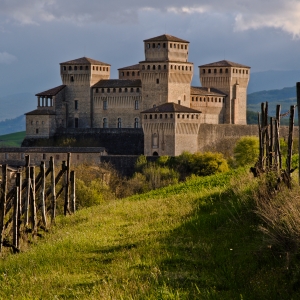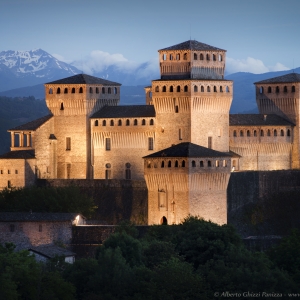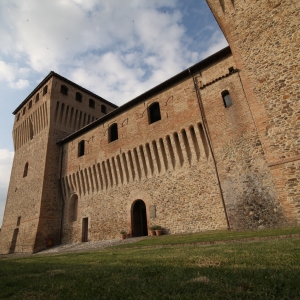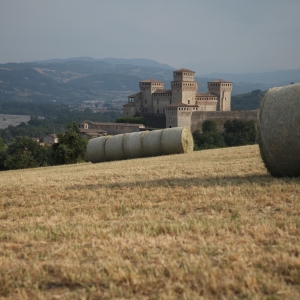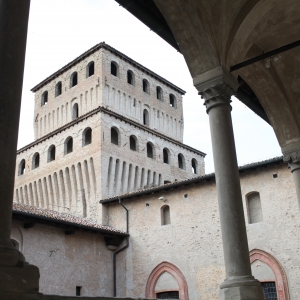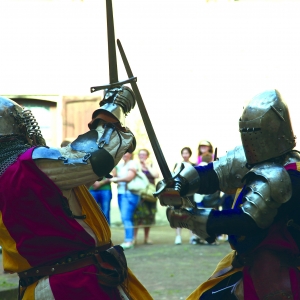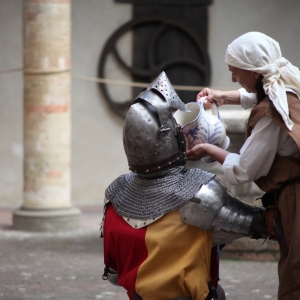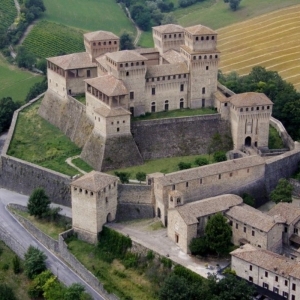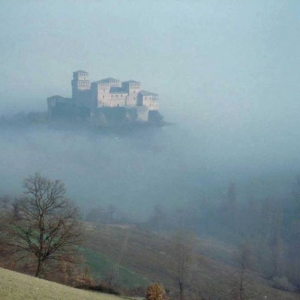Open today
Castello di Torrechiara
A pearl of rare artistic value and an incredibly evocative apparition for those arriving at Langhirano on their way up the ancient 'Parma Ham Valley', among the gentle hills embroidered with Malvasia and Sauvignon (D.O.C.) vineyards. A perfect combination of Medieval and Renaissance elements, the castle was built by the nobleman Pier Maria Rossi between 1448 and 1460 for his lover Bianca Pellegrini d'Arluno, on a hill overlooking the valley of the Parma stream: this position, now suggestively panoramic, was once strategic to ensure control over the territory.
Torrechiara Castle is part of the Castles of the Duchy circuit.
Pier Maria Rossi, Count of Berceto, Marquis of San Secondo, is certainly one of the most interesting
characters of the 15th century, often compared to Lorenzo the Magnificent. To the talents of the valiant military commander he combined those of a fine humanist and cultured intellectual, a lover of music and poetry, knowledgeable in astrological, mathematical and architectural sciences: he himself was probably the architect of the complex project of the Torrechiara manor and it seems that the bastions and curtain walls of the castle reveal proportional relationships that can be related to musical consonances, inspired by Pythagorean-Platonic geometry that influenced Renaissance art.
In his long frequentation of the Milanese court, Rossi achieved important military successes as a captain in the service first of the Visconti and then of the Sforza, but he did not escape the fatal dart of Cupid! Here he meets and falls in love with the noblewoman Bianca Pellegrini, who will abandon her husband and her land to follow him. He builds for her the "Altiera ed felice" alcove of Torrechiara, a mighty fortress protected by three walls and four angular towers, but with a "gentle" heart, a harmonious fusion of the functional characteristics of a fortress with the elegance and refinement typical of a noble residence: the slender and very long corbels that adorn the angular towers, slender and light against the masculine base of the fortress, conceal their defensive utility and are admired for their abstract beauty. The
interior offers visitors a riot of frescoed rooms, including the splendid Camera d'Oro, considered one of the highest pictorial expressions of international Gothic in Italy: the room celebrates the triumph of the love of Pier Maria and Bianca, but also the prestige of the Rossi family in the Parma area, through the imaginary journey of Bianca, a "pilgrim" for love, among the vast possessions and lands of the feud. This admirable masterpiece attributed to Benedetto Bembo, a precious iconographic document for its precise and meticulous 'true-to-life' description of the castles and the territory, envelops and involves the visitor in a dynamic, almost 'cinematographic' succession of scenes, where the protagonist advances with gentle gracefulness among the Apennine crags, under a sun that quilts the cobalt-patinated sky with flaming golden rays. The gold that can still be seen in the glow of the stars, in the foliage and brocades of the clothes, once entirely covered the terracotta tiles that embroider the lower part of the walls, flooding the visitors to the room, from which it took its name, with light. The memory of that magic is now only evoked in the sober and 'naked' red tiles, where the hearts of the two lovers, entwined in an embrace 'digne et in eternum', stand out. The "grotesque" frescoes of the other representative rooms of the manor house, painted by Cesare Baglione and his collaborators, Giovanni Antonio Paganino and Innocenzo Martini, are also of the highest quality: the Hall of Coats of Arms, the Hall of Jupiter, the Hall of the Pergola, the Hall of Angels, the Hall of Landscapes, the Hall of Victory, the Hall of the Velarium, the Hall of Hunting and Fishing and the magnificent Hall of Acrobats.
The architectural complex, which alternates these precious rooms with service areas such as the kitchens and stables, is distributed on two floors around the prestigious Cortile d'Onore, today the scene of important summer shows and events. Also
overlooking the courtyard is the court chapel, known as the Chapel of San Nicomede, which once housed the important polyptych depicting the Madonna Enthroned with Child and Saints Antonio Abbate, Nicomede and Peter Martyr of 1462, by Benedetto Bembo (now in the Sforza Castle Museum in Milan).
The castle structure has an extensive and interesting underground system of dungeons, which are open for visits on some extraordinary occasions. The latest restorations have also made the original and scenic patrol walkways
accessible again.
Not to be missed, inside the imposing fortified walls that surround the castle, is a walk among the houses of the delightful medieval village, which preserves intact the original building layout of the ancient settlement attached to the castle. Torrechiara Castle is part of the Castles of the Duchy circuit.


